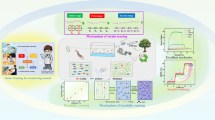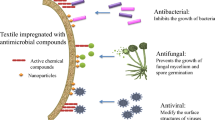Abstract
Recently, self-cleaning/superhydrophobic surface modifications have become an important and demandable field in the textile industry. Superhydrophobicity is the leading property in obtaining dirt and dust-free self-cleaning surfaces. However, water is essential for removing dust or dirt particles from a superhydrophobic surface. In this study, another important factor is introduced to develop the capability of dust removing and reducing the attraction of dirt particles by using the antistatic property. Generally, when wearing any garment, electric charges are generated by moving or rubbing the fabric. After applying the property of zero charges on the fabric surface, the fabric reduces the attraction of dirt particles as they implement weak attraction forces with the fabric surface. Here in, a method is developed in obtaining superhydrophobic performance of textiles in which the method can be expressed as the single side superhydrophobic surface by screen printing method. All the types of methods are followed by based on the Zn(Ac)2, NH4F, Titanium(iv) isopropoxide (TTIP), Stearic acid and each of those differ by the preparation method, and the coating method. The fabric and materials are characterized with Fourier Transform Infrared Spectroscopy (FTIR), powder X-ray diffraction (XRD), Scanning electron microscope (SEM). The surface wettability is analyzed by contact angle measurer and roll-off angle measurer and the antistatic property is analyzed by multi-meter and Gold leaf electroscopic method. The surface modified antistatic/superhydrophobic surface is performing their average resistivity in the range of antistatic range at about 4.85 × 106 Ω cm−1 and it is proved by the Gold leaf electroscope. The water contact angle of the modified fabric surface is 157.54° which means that the surface is superhydrophobic. The surface modification has not been affected on the appearance of the fabric due to the higher transparency of the antistatic/superhydrophobic thin-film. There is no significant change of the superhydrophobicity up to 20th. Therefore, the devised methods are useful to produce superhydrophobic cotton textiles.

Graphical abstract
Highlights
-
A heterogeneous superhydrophobic surface is applied by a simple screen-printing method.
-
Stearic acid SAMs layer is grown around the TiO2 particles with a temperature gradient.
-
F doped ZnO nanostructures are bonded covalently with Chloroacetic acid/PVA binder.
-
Low surface energy/conductive surfaces have reduced the attraction of dust/dirt.









Similar content being viewed by others
References
Choi D, Yoo J, Park SM, Kim DS (2017) Facile and cost-effective fabrication of patternable superhydrophobic surfaces via salt dissolution assisted etching. Appl Surf Sci 393:449–456. https://doi.org/10.1016/j.apsusc.2016.10.057
Otitoju TA, Ahmad AL, Ooi BS (2017) Superhydrophilic (superwetting) surfaces: a review on fabrication and application. J Ind Eng Chem 47:19–40. https://doi.org/10.1016/j.jiec.2016.12.016
Krishnan KG, Milionis A, Loth E, Farrell TE, Crouch JD, Berry DH (2017) Influence of hydrophobic and superhydrophobic surfaces on reducing aerodynamic insect residues. Appl Surf Sci 392:723–731. https://doi.org/10.1016/j.apsusc.2016.09.096
Sarif Ullah Patwary MS (2015) Smart textiles and nano-technology: a general overview. J Text Sci Eng 5. https://doi.org/10.4172/2165-8064.1000181.
Blanes M, Marco B, Gisbert MJ, Bonet MA, Balart R (2010) Surface modification of polypropylene non-woven substrates by padding with antistatic agents for deposition of polyvinyl alcohol nanofiber webs by electrospinning. Text Res J 80:1335–1346. https://doi.org/10.1177/0040517509358801
Zhang M, Wang C (2013) Fabrication of cotton fabric with superhydrophobicity and flame retardancy. Carbohydr Polym 96:396–402. https://doi.org/10.1016/j.carbpol.2013.04.025
He A, Liu W, Xue W, Yang H, Cao Y (2018) Nanosecond laser-ablated copper superhydrophobic surface with tunable ultrahigh adhesion and its renewability with low temperature annealing. Appl Surf Sci 434:120–125. https://doi.org/10.1016/j.apsusc.2017.10.143
Zhu J (2018) A novel fabrication of superhydrophobic surfaces on aluminum substrate. Appl Surf Sci 447:363–367. https://doi.org/10.1016/j.apsusc.2018.04.014
Antuono M, Durante D (2018) Analytic solutions for unsteady flows over a superhydrophobic surface. Appl Math Model 57:85–104. https://doi.org/10.1016/j.apm.2017.12.032
Ruiz-Cabello FJM, Ibáñez-Ibáñez PF, Gómez-Lopera JF, Martínez-Aroza J, Cabrerizo-Vílchez M, Rodríguez-Valverde MA (2017) Testing the performance of superhydrophobic aluminum surfaces. J Colloid Interface Sci 508:129–136. https://doi.org/10.1016/j.jcis.2017.08.032
Yu T, Lu S, Xu W, He G (2018) Fabrication of bismuth superhydrophobic surface on zinc substrate. J Solid State Chem 262:26–37. https://doi.org/10.1016/j.jssc.2018.02.019
An introduction to antistatic, dissipative, and conductive plastics—craftech industries—high-performance plastics. http://www.craftechind.com/an-introduction-to-antistatic-dissipative-and-conductive-plastics/. Accessed 10 May 2019
Roessler A, Schottenberger H (2014) Antistatic coatings for wood-floorings by imidazolium salt-based ionic liquids. Prog Org Coat 77:579–582. https://doi.org/10.1016/j.porgcoat.2013.11.022
Guo J, Shen X, Bai L, Chen W(2006) Anti-static agent containing zinc oxide and its modification for pa6 fiber antistatic agent containing zinc oxide and its modification for PA6 fiber J Macromol Sci 43:1671–1677. https://doi.org/10.1080/10601320600934859
Campos R, Guenthner AJ, Meuler AJ, Tuteja A (2012) Superoleophobic surfaces through control of sprayed- on stochastic topography. Langmuir 28:9834–9841. https://doi.org/10.1021/la301480s
Fortunato E, Correia N, Barquinha P, Pereira L, Goncalves G, Martins R (2008) High-performance flexible hybrid field-effect transistors based on cellulose fiber paper. IEEE Electron Device Lett 29:988–990. https://doi.org/10.1109/LED.2008.2001549
Guo Z, Yang F (2018) Superhydrophobic surfaces from nature and beyond nature. In: Surfaces interfaces of biomimetic superhydrophobic materials. Wiley publisher, Hoboken, New Jersey. pp. 25–57. https://doi.org/10.1002/9783527806720.ch2.
Yeganeh M, Mohammadi N (2018) Superhydrophobic surface of Mg alloys: a review. J Magnes Alloy 000:1–12. https://doi.org/10.1016/j.jma.2018.02.001
Das S, Kumar S, Samal SK, Mohanty S, Nayak SK (2018) A review on superhydrophobic polymer nanocoatings: recent development and applications. Ind Eng Chem Res 57:2727–2745. https://doi.org/10.1021/acs.iecr.7b04887
Nine MJ, Cole MA, Johnson L, Tran DNH, Losic D(2015) superhydrophobic graphene-based composite coatings with self-cleaning and corrosion barrier properties ACS Appl Mater Interfaces 7:28482–28493. https://doi.org/10.1021/acsami.5b09611
Pawar PG, Xing R, Kambale RC, Kumar AM, Liu S, Latthe SS (2017) Polystyrene assisted superhydrophobic silica coatings with surface protection and self-cleaning approach. Prog Org Coat 105:235–244. https://doi.org/10.1016/j.porgcoat.2017.01.016
Favia P, Cicala G, Milella A, Palumbo F, Rossini P, d’Agostino R (2015) Deposition of super-hydrophobic fluorocarbon coatings in modulated RF glow discharges. Surf Coat Technol 169–170:609–612. https://doi.org/10.1016/S0257-8972(03)00123-3
Liou N-S, Choo K, Julai S, Ching Y, Chuah C (2016) Preparation and characterization of polyvinyl alcohol-chitosan composite films reinforced with cellulose nanofiber. Materials 9:644. https://doi.org/10.3390/ma9080644
Anicuta S, Dobre L, Stroescu M, and Jipa I (2010) Fourier transform infrared (FTIR) spectroscopy for characterization of antimicrobial films containing chitosan, Analele Univ. din Oradea Fasc. Ecotoxicologie, Zooteh. si TehnolInd. Aliment 1234–1240
dos Reis EF, Campose FS, Lage AP, Leite RC (2006) Synthesis and characterization of poly (vinyl alcohol) hydrogels and hybrids for rMPB70 protein adsorption. Mater Res 9:185–191. https://doi.org/10.1590/S1516-14392006000200014
Raju CHL, Rao JL, Reddy BCV, Brahmam KV (2007) Thermal and IR studies on copper doped polyvinyl alcohol. Bull Mater Sci 30:215–218. https://doi.org/10.1007/s12034-007-0038-1
Troyon M, Bougrine A, Addou M, Bubendorff JL, El Hichou A, Eboth J (2003) Structural, optical and cathodoluminescence characteristics of sprayed undoped and fluorine-doped ZnO thin films. Semicond Sci Technol 17:607–613. https://doi.org/10.1088/0268-1242/17/6/318
Kim I, Lee KS, Lee TS, Jeong J, Cheong B, Baik YJ, Kim WM (2006) Effect of fluorine addition on transparent and conducting Al-doped ZnO films. J Appl Phys 100:063701. https://doi.org/10.1063/1.2347715
Chiarello GL, Di Paola A, Palmisano L, Selli E (2011) Effect of titanium dioxide crystalline structure on the photocatalytic production of hydrogen. Photochem Photobiol Sci 10:355–360. https://doi.org/10.1039/c0pp00154f
Diebold U (2003) The surface science of titanium dioxide. Surf Sci Rep 48:53–229. https://doi.org/10.1016/S0167-5729(02)00100-0
Landmann M, Rauls E, Schmidt WG (2012) The electronic structure and optical response of rutile, anatase and brookite TiO2. J Phys Condens Matter 24:195503. https://doi.org/10.1088/0953-8984/24/19/195503
Hwang SH, Song J, Jung Y, Kweon OY, Song H, Jang J (2011) Electrospun ZnO/TiO2 composite nanofibers as a bactericidal agent. Chem Commun 47:9164–9166. https://doi.org/10.1039/c1cc12872h
Mani J, Sakeek H, Habouti S, Dietze M, Es-Souni M (2012) Macro-meso-porous TiO2, ZnO and ZnO-TiO2-composite thick films. Properties and application to photocatalysis. Catal Sci Technol 2:379–385. https://doi.org/10.1039/c1cy00302j
Tsai SJ, Cheng S (1997) Effect of TiO2 crystalline structure in photocatalytic degradation of phenolic contaminants. Catal Today 33:227–237. https://doi.org/10.1016/S0920-5861(96)00152-6
Kaygili O, Bulut N, Tatar C, Ates T, İnce T (2017) Sol-gel synthesis and characterization of TiO2 powder Int J Innov Eng Appl 2:38–40
Xu L, Zhang Y, Guo Y, Zhang R (2020) The effect of hydroxyl on the superhydrophobicity of dodecyl methacrylate (LMA) coated fabrics through simple dipping-plasma crosslinked method. Coatings 10:1–11. https://doi.org/10.3390/coatings10121263
Zeng C, Wang H, Zhou H, Lin T (2015) Self-cleaning, superhydrophobic cotton fabrics with excellent washing durability, solvent resistance and chemical stability prepared from an SU-8 derived surface coating. RSC Adv 5:61044–61050. https://doi.org/10.1039/C5RA08040A
Xue C, Bai X, Jia S (2016) Robust, self-healing superhydrophobic fabrics prepared by one-step coating of PDMS and octadecylamine. Sci Rep 6:1–11. https://doi.org/10.1038/srep27262
Gong X, He S (2020) Highly durable superhydrophobic polydimethylsiloxane/silica nanocomposite surfaces with good self-cleaning ability. ACS Omega 5:4100–4108. https://doi.org/10.1021/acsomega.9b03775
Khaskhoussi A, Calabrese L and Proverbio E (2020) Superhydrophobic self-assembled silane monolayers on hierarchical 6082 aluminum alloy for anti-corrosion applications. Appl. Sci. 10. https://doi.org/10.3390/APP10082656
Author information
Authors and Affiliations
Corresponding author
Additional information
Publisher’s note Springer Nature remains neutral with regard to jurisdictional claims in published maps and institutional affiliations.
Rights and permissions
About this article
Cite this article
Thennakoon, C.A., Rajapakshe, R.B.S.D., Rajapakse, R.M.G. et al. Anti-stain and durable superhydrophobic/antistatic dual functionality surface for fabric materials based on F-ZnO/TiO2 composite. J Sol-Gel Sci Technol 101, 529–538 (2022). https://doi.org/10.1007/s10971-022-05734-y
Received:
Accepted:
Published:
Issue Date:
DOI: https://doi.org/10.1007/s10971-022-05734-y




